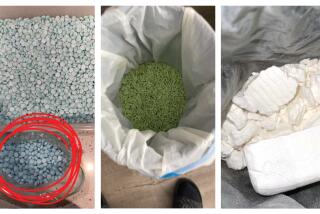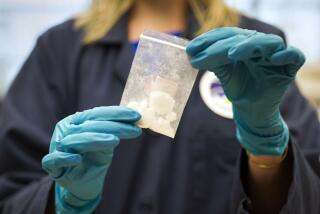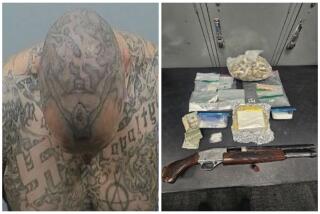Chemist, Alleged Colleague Arrested in N. Hollywood : 2 Accused of Operating Synthetic Heroin Lab
Two North Hollywood men, one with a doctorate in chemistry, were arraigned Thursday in U. S. District Court on charges that they attempted to manufacture fentanyl, a form of synthetic heroin known as “China white.”
Luther Dickson, 46, and Larry King, 39, who also were charged with selling cocaine and conspiring to manufacture methamphetamine, were taken to Federal Correctional Institution at Terminal Island after being denied bail by federal Magistrate Volney V. Brown Jr.
Dwight McKinney, U. S. Drug Enforcement Administration spokesman, said the two were arrested late Wednesday at an “operational laboratory” in the 11500 block of Lamaida Street.
A forensic chemist estimated that there were enough chemicals in the lab to manufacture 100 million doses of the drug, McKinney said. Doses sell for up to $5 each, he said.
DEA officials say fentanyl is 100 to 5,000 times more potent than morphine or heroin, and blame the drug for more than 100 overdose deaths nationwide in the last two years.
Two Arrested in 1985
Dickson, who has a Ph.D. in chemistry, was arrested along with King in June, 1985, at the same North Hollywood address after authorities found a fentanyl laboratory there, McKinney said.
Investigators said they confiscated about the same amount of chemicals in that raid as they did Wednesday.
State charges were filed in the 1985 case but later dropped because federal narcotics agents refused to identify an informant and wanted to continue a wiretap, McKinney said.
Similar charges were filed by federal authorities Thursday, he said.
‘Designer Drug’
Federal authorities list fentanyl as one of several so-called “designer drugs” manufactured by chemists in clandestine laboratories.
Until recently, most designer drugs were legal. By changing the molecular structure of fentanyl, a surgical anesthetic that is the most common base for designer drugs, chemists were able to create legal heroin-like variants, according to DEA officials.
By the time scientists were able to decipher the chemical structure of a new drug and governments would outlaw it, chemists would alter the chemical components slightly, creating new and legal chemical cousins.
More to Read
Sign up for Essential California
The most important California stories and recommendations in your inbox every morning.
You may occasionally receive promotional content from the Los Angeles Times.










